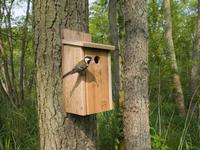Bird nest boxes for your garden birds

Nest boxes are good substitutes for holes found in old trees. Nowadays, in many gardens, there may be plenty of food for small birds but nowhere for hole-nesting birds to nest.
There are many garden birds which use nest boxes; blue tits, great tits, coal tits, nuthatches, house sparrows and tree sparrows, starlings, spotted and pied flycatchers, robins, house martins, kestrels and tawny owls will all use nest boxes.
Models like the Schwegler 1B nest box appeals to tits and nuthatches. If you are keen to help wrens, try siting a Roundhouse nest box for wrens in thick undergrowth. Avianex Woodcrete Plus nest boxes are tough and weather proof and offer good thermal insulation to nesting birds. An alternative to Avianex Woodcrete are natural wood nest boxes. Wood nest boxes, such as the CedarPlus range are tough, durable and easily cleaned. Entrance hole protection plates protect against nest boxes from attack by squirrels, magpies and other predators. Nets box guardians make it much harder for predators to gain access to the nest box, whilst still letting the parent birds in.
Where you site a nest box will depend on the species of bird the box is intended for. Put up different boxes to attract several different bird species. Nest boxes for tits, sparrows or starlings should be fixed two to four meters high. House sparrows and starlings nest in loose colonies so you can site two or three nest boxes close together. Open-fronted robin boxes and wren Roundhouses need to be sited below 2m and well hidden in vegetation like ivy, honeysuckle or other climbing plants. Woodpecker boxes need to be 3-5m high on a tree trunk in a quiet location where it won’t be disturbed. Unless the box is shaded during the day, the nest box should be facing between North and East – avoiding strong sunlight and wettest winds. Garden birds need a clear flight path to the nest without any clutter in front of the nest box entrance. It is best to put up nest boxes in the Autumn. Many birds will use bird nest boxes during the Autumn and Winter for roosting and perhaps feeding. They often use the same boxes for nesting the following Spring.
After use, most nest boxes will harbour fleas and other parasites, which remain to infest young birds that hatch the following year. Old nests should be removed in the Autumn once birds have stopped using the boxes. Thoroughly clean the nest box to kill any remaining parasites and then let the box dry out thoroughly before replacing the lid. Un-hatched eggs in a nest box can only legally be removed between August and January. Cold weather and food shortage can lead to nest desertion. It is important not to inspect nest boxes that are in use. If you want to see chicks as they grow you can install a nest box camera. Nest box cameras are a really good way of watching adult birds raises their brood. National Nest Box week takes place in the UK each February.
Visit streetendfeeds.co.uk to view a range of bird nest boxes.

